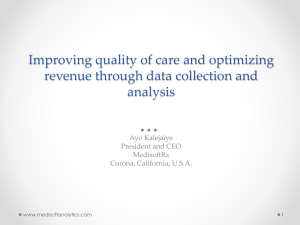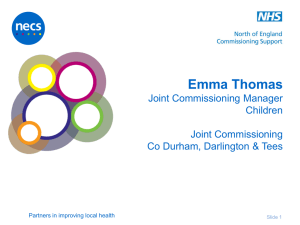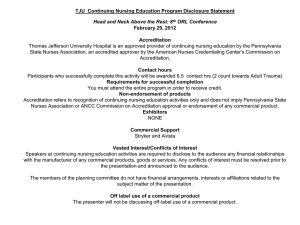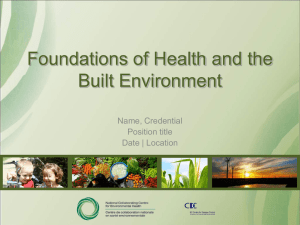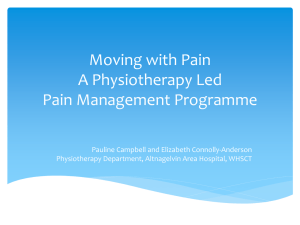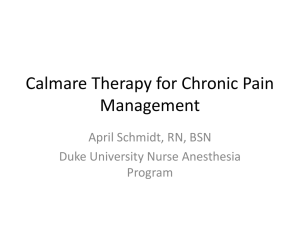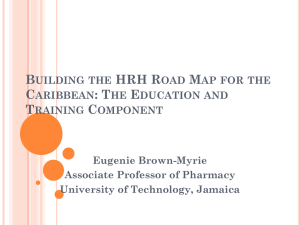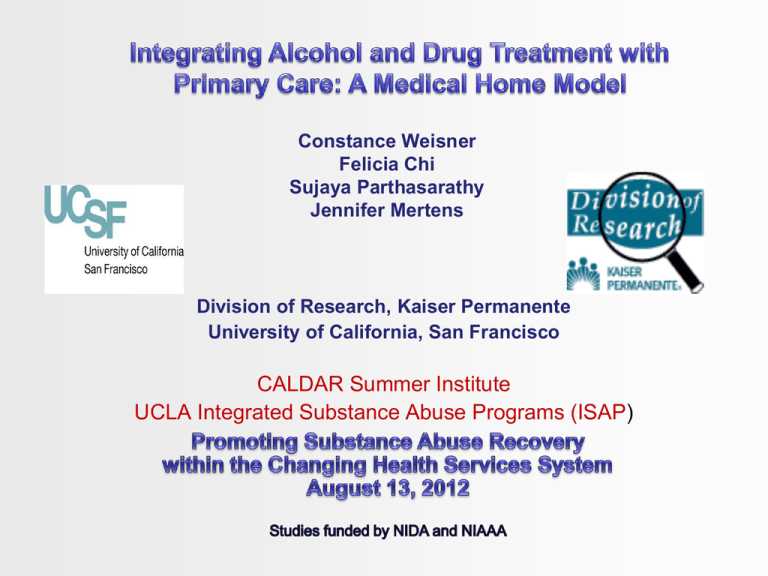
Constance Weisner
Felicia Chi
Sujaya Parthasarathy
Jennifer Mertens
Division of Research, Kaiser Permanente
University of California, San Francisco
CALDAR Summer Institute
UCLA Integrated Substance Abuse Programs (ISAP)
Overview
Integrating Substance Use services with health care
• A conceptual model of integration using primary care
• Development of approach
• Screening, Brief Intervention, and Referral to SU Treatment
• Integrating care during SU treatment
• Continuing Care following SU treatment
• Research Opportunities
Primary care as the anchor for ongoing medical care,
monitoring of SU and mental health problems
Disease Management/Chronic Care Approach
Individuals with a serious chronic problem (e.g., diabetes) are treated in
specialty care, and when stabilized return to primary care for
management and monitoring
Similarly, alcohol and drug dependence are chronic
conditions requiring ongoing care or management
delivered in more than one setting
Von Korff M, Gruman J, Schaefer J, Curry SJ, Wagner EH. Collaborative management of chronic
illness. Ann Intern Med. 1997;127:1097-102.
Institute of Medicine. Improving the quality of health care for mental and substance-use conditions:
Quality Chasm series. Washington, DC: National Academies Press; 2005
What might a continuing care model
for alcohol and drug problems look like?
Screen and treat in PC if
moderate problem &
continue monitoring
Refer to SU treatment if
needed
Primary
Care
Specialty SU
Care
Back to PC for monitoring &
possible readmission
Von Korff M, Gruman J, Schaefer J, Curry SJ, Wagner EH. Collaborative management of chronic illness. Ann Intern Med.
1997;127:1097-102.
Bodenheimer T, Wagner EH, Grumback K. Improving primary care for patients with chronic illness. JAMA 2002; 288:1775-9.
Why Primary Care?
Community Epidemiology Laboratory
General Population
Survey
Agency Systems
Alcohol Treatment (22)
Drug Treatment (8)
Mental Health (8)
Welfare (7)
Emergency Room (4)
Primary Health Care (5)
Criminal Justice (1)
Weisner, Schmidt & Tam. Addiction, 1995.
Prevalence of New Admissions of Problem Drinkers across
General Population & Community Agency Caseloads (%)
100
91
80
60
50
40
20
0
53
33
22
11
15
7
24
11
General Private Public Private Public Welfare Mental Jail
Drug
Population Primary Primary ER
ER
(621) Health (1147) Trtmt
(3069)
Care
Care (1102) (801)
(406)
(304)
(358)
(394)
Alcohol
Trtmt
(381)
Data are weighted to adjust each sample for variation in agencies sampling fraction, rate, and fieldwork duration.
Distribution of New Admissions1 of Alcohol Dependent2
Individuals in Community Agency Systems
Alcohol and DrugTreatment 11.1%
Welfare 6.6%
Mental Health 3.0%
Primary Care 55.7%
Criminal Justice
23.5%
1
Data weighed for design effects, non-response, and to a common fieldwork duration so that
each agency system sample is shown to its size.
2 Dependence rates over a base of those meeting DSM-III-R criteria across all agency systems.
Distribution of New Admissions1 of Weekly
2
Drug Users in Community Agency Systems
Alcohol and Drug Treatment 6%
Welfare 11%
Mental Health 3%
Primary Care 43%
Criminal Justice 39%
1
Data weighed for design effects, non-response, and to a common fieldwork duration so that each
agency system sample is shown to its size.
2 Weekly drug use rates over a base of weekly drug users across all agency systems.
Why primary care?
• Screening
• Ongoing care
Monitoring
Referral back to SU treatment when needed
•
Staff-model
integrated
health care
delivery
system
(medical,
psychiatry,
SU services)
•
Serves 3.4
million
members
(about 40%
of insured
population in
the region)
•
18 hospitals,
27 SU and
MH
outpatient
clinics
•
Electronic
medical
record
•
Similarities
wtih FQHC’s
Screening and Intervention in
Primary Care
Hazardous Drinkers and Drug Users in Primary Care
•
Prevalence of 10% for either alcohol or drug problems
•
Hazardous drinkers and drug users had higher
prevalence than other primary care patients of several
common medical conditions, including:
• Injury
• Hypertension
• Asthma, emphysema, COPD
• Pneumonia
• Depression, Anxiety, and Major Psychoses
•
Higher health care costs
•
Important for care of chronic conditions (including
diabetes)
Mertens JM, Weisner C, Ray GT, Fireman B, Walsh K. Hazardous drinkers and drug users in HMO primary care:
prevalence, medical conditions, and costs. Alcohol Clin Exp Res. 2005;29:989-98.
Ahmed A, Karter AJ, Warton M, Doan JU, Weisner C. The relationship between alcohol consumption and
glycemic control among patients with diabetes differs by age and diabetes type: the Kaiser Permanente Northern
California Diabetes Registry. J Gen Intern Med. 2008;23 (3):275-282.
Medical Conditions: Example from a FQHC
Medical conditions
With any SU
Without any SU
P value
Depression
22.8
11.6
<0.0001
Major Psychosis
7.3
4.0
0.0184
Any Mental Health diagnosis
30.1
18.8
<0.0001
Low back pain
28.5
10.0
<0.0001
Other pain/chronic pain
50.4
41.6
0.0096
Infectious/parasitic disorders
14.6
10.3
0.0436
Pulmonary /respiratory- COPD
3.7
1.3
0.0118
Hypertension
37.4
31.0
0.0446
Psychiatric
Medical
Screening, Intervention, and Referral to
Treatment in Primary Care:
Evidence Base and Research Need
• SBIRT in primary care is effective, cost effective,
and recommended by national guidelines but
has not been widely adopted
• Only a few rigorous implementation studies have
been conducted in the U.S.
Bertholet N, Daeppen JB, Wietlisbach V, et al. Arch Intern Med. 2005;165:986-995.
Whitlock EP, Polen MR, Green CA, et al. Ann Intern Med. 2004;140:557-568.
Solberg LI, Maciosek MV, Edwards NM. Am J Prev Med. 2008 Feb;34(2):143-152.
Saitz R, Svikis D, D'Onofrio G, et al. Alcohol Clin Exp Res. 2006;30:332-338.
At-Risk Drinking In Primary Care
Need Specialty
Treatment
Brief Intervention
Alcohol Dependent
7.5%
At-Risk Drinkers
Low-Risk Drinkers
Abstainers
Institute of Medicine. 1990, and World Health Organization, 2001
Helping Patients Who Drink
Too Much:
Kaiser’s SBIRT study
NIAAA: PI Jennifer Mertens
Implementation study of effective interventions
Randomization
56 Facilities
1/3 of PC modules
randomized
to PCP Arm
PCPs receive
SBIRT training with CMEs
1/3 of PC modules
randomized
to ‘NPP’ arm
•MAs are trained to Screen
•BMS/Nurses/CHEs
•Receive training (with
CME/CEUs) to conduct
BI and RT
1/3 of PC modules
randomized to
control condition
Informational session on
how to access and use
Alcohol Screener
Alcohol Screener in EMR
19
Best Practice Alert
20
Primary Outcomes (using the EMR)
•
•
•
•
Screening rates
Brief intervention rates
Referral to treatment rates
Cost and utilization
Secondary Outcomes (Using the EMR)
•Compare Effectiveness by Study Arm.
•Effectiveness on patient outcomes of:
typical quantity consumed
days per week consumed alcohol
average weekly consumption
•Related health outcomes:
blood pressure reductions for patients with
hypertension diagnoses and,
antidepressant adherence (consistent with HEDIS
standards) for patients with depression diagnoses
who have antidepressant prescriptions.
What might a continuing care model
for alcohol and drug problems look like?
Screen and treat in PC if
moderate problem &
continue monitoring
Refer to SU treatment if
needed
Primary
Care
Specialty SU
Care
Back to PC for monitoring &
possible readmission
Von Korff M, Gruman J, Schaefer J, Curry SJ, Wagner EH. Collaborative management of chronic illness. Ann Intern Med.
1997;127:1097-102.
Bodenheimer T, Wagner EH, Grumback K. Improving primary care for patients with chronic illness. JAMA 2002; 288:1775-9.
Integration with Primary Care:
During SU Treatment
• In specialty care we have a more
select population – with high rates of
medical and psychiatric problems
Controls Prevalence in Adult SU Treatment Patients Vs. Matched (%)
(more than 20 conditions)
Acid-Related Disorder
Arthritis
Asthma
COPD
Migraine
Hypertension
Lower Back Pain
Injury
Controls
SU patients
0
5
10
15
20
25
Conditional Logistic Regression Results: p<0.01 for all conditions shown
Mertens et al. (2003). Archives of Internal Medicine 163: 2511-2517.
30
Prevalence in Adult SU Treatment Patients Vs. Matched Controls (%):
ICD-9 Psychiatric Conditions*
SU Patients
(N=747)
Matched Members
(N=3,690)
Depressive Disorders
28.5%
2.7%
Anxiety Disorders
17.1%
2.2%
Psychoses
6.7%
0.4%
*all p<.001
Mertens JR, Lu Y, Parthasarathy S, Moore C, Weisner CM. Medical and psychiatric conditions of alcohol and
drug treatment patients in an HMO: Comparison to matched controls. Arch Intern Med. Nov 10 2003;163:25112517.
Integrating Primary Medical Care During SU
Treatment: Evidence Base
• Systematic reviews indicate that a small but
growing literature suggests effectiveness of
integrating primary medical care during SU
treatment, but:
Few randomized trials
Lack cost-effectiveness analysis
Butler M, Kane RL, et al. Integration of Mental Health/Substance Abuse and Primary Care.
AHRQ Publication No 09-E003. October 2008.
Druss BG and von Esenwein SA. General Hospital Psychiatry. 2006; 28(2): 145-53.
Willenbring ML and Olson D. Arch Intern Med. 1999; 159 (16): 1946-52.
Friedman P, Zhang Z, et al. J Gen Int Med. 2003; 18: 1-8.
Outcomes of Integrating During
SU Treatment
Randomized those entering SU treatment to receiving
their primary care in the SU clinic vs. receiving it as
usual care in the clinics.
Those with medical problems receiving integrated
services were almost twice as likely to be abstinent at
6 months, and was cost-effective.
There is still an effect at five years.
Weisner C, Mertens J, Parthasarathy S, Moore C. Integrating primary medical care with addiction
treatment: A randomized controlled trial. JAMA. Oct 2001;286(14):1715-1723.
Mertens JR, Flisher AJ, Satre DD, Weisner C. (2008). The role of medical conditions and primary
care services in 5-year substance use outcomes among chemical dependency treatment patients.
Drug and Alcohol Dependence 98(1-2):45-53.
What might a continuing care model
for alcohol and drug problems look like?
Screen and treat in PC if
moderate problem &
continue monitoring
Refer to SU treatment if
needed
Primary
Care
Specialty SU
Care
Back to PC for monitoring &
possible readmission
Von Korff M, Gruman J, Schaefer J, Curry SJ, Wagner EH. Collaborative management of chronic illness. Ann Intern Med.
1997;127:1097-102.
Bodenheimer T, Wagner EH, Grumback K. Improving primary care for patients with chronic illness. JAMA 2002; 288:1775-9.
Case for Primary Care Continuity
after SU Treatment
• SU treatment population has a high level
of chronic or on-going medical and mental
health conditions
• It’s unrealistic to expect that chronic health
problems will disappear with SU treatment
• Health problems can cause relapse
• A mechanism to continue to monitor SU
problems
Conceptual Approach:
Disease Management/Chronic Care Approach
• Individual with a serious chronic problem (e.g., diabetes)
is treated in specialty care, and when stabilized returns
to PC for management and monitoring
referred back to specialty care for services as needed
in the course of their health care
• Similarly, SU dependences is a chronic condition
requiring ongoing care or management delivered in more
than one setting
• Not replacing aftercare – can be placed on top of all
types of aftercare
Von Korff M, Gruman J, Schaefer J, Curry SJ, Wagner EH. Collaborative management of chronic
illness. Ann Intern Med. 1997;127:1097-102.
Institute of Medicine. Improving the quality of health care for mental and substance-use conditions:
Quality Chasm series. Washington, DC: National Academies Press; 2005
A Model of Continuing Care Following
SU Treatment
Observational study as a first step informing an intervention
Three components:
1) Regular primary care as anchor
2) Readmission to SU treatment when needed
3) Psychiatric services when needed
Patient characteristics and data sources of patients
at 1 year, 5 year, 7 year and 9 year follow-ups)
•
KP Chemical Dependency Recovery Program (CDRP) in
Sacramento, California
•
Study participants: 1,951 adult individuals (i.e. 18 years or
older) entering treatment at the CDRP during April 1994 –
April 1996 and April 1997 – December 1998 (93% of
intakes)
•
Follow-up interviews at 1 year, 5 years, 7 years and 9 years,
with response rates of 90%, 86%, 84%, and 78%
A Model of Continuing Care Following SU Treatment
•
Need for specialty care:
√ having a non-zero Addiction Severity Index (ASI)
score for the corresponding SU or MH problem
domain at the prior interview time point
•
Membership and service utilization from the
health plan’s administrative databases
Nine-Year Primary Care-Based
Continuing Care Outcomes
(Observational Study)
• Patients receiving continuing care were more than
twice as likely to be remitted at each follow-up over 9
years (p<.0001).*
√ Results were consistent by gender, medical
and psychiatric severity, and for all age groups
except those older than 50 years.
* mixed-effects logistic regression model controlling for
time/follow-up wave, demographic characteristics, severity, and
completion of index SU treatment
Chi FW, Parthasarathy S, Mertens JR, Weisner C. (2011). Continuing care and long-term
substance use outcomes in managed care: initial evidence for a primary care based
model. Psychiatr Serv 62(10):1194–200..
Receiving Continuing Care1 vs. Remission Over 9 Years,
Stratified Analyses2
Adjusted
OR
95% CI
P value
2.38
(1.59, 3.57)
<0.0001
20-29 years
5.11
(1.63, 15.97)
0.0055
30-39 years
2.52
(1.24, 5.13)
0.0124
40-49 years
2.14
(1.10, 4.20)
0.0182
≥ 50 years
0.90
(0.30, 2.71)
N.S.
Female
1.80
(1.03, 3.16)
0.0202
Male
3.11
(1.70, 5.70)
0.0003
High
2.45
(1.39, 4.31)
0.0025
Low
2.28
(1.25, 4.16)
0.0031
High
2.80
(1.56, 5.03)
0.0004
Low
1.87
(1.04, 3.36)
0.0272
All
Age group
Gender
Baseline medical severity
Baseline psychiatric
severity
Note:
1 Receiving continuing care was defined as having regular PC and receiving both CD and psychiatric services when needed.
2 All models adjusted for the same set of covariates as in the model presented in the previous slide.
Nine-Year Primary Care-Based Continuing Care Costs
(Observational Study)
• Those receiving continuing care in the prior interval were
less likely to have ER visits and hospitalizations
subsequently (p<.05).*
*Linear mixed model controlling for age, gender, employment and marital
status, whether completed treatment
Parthasarathy S, Chi FW, Mertens JR, Weisner C. (2012). The role of continuing care on 9-year
cost trajectories of patients with intakes into an outpatient alcohol and drug treatment program.
Med Care 50(6): 540-6.
Average Cost per Member Month
Average Costs by
Number of Continuing Care Components
$350
Other Costs
$300
$250
CD Treatment COst
$200
$150
Psychiatric Services
Cost
$100
Primary Care Cost
$50
ER Cost
$0
0
1
2
3
Number of Continuing Care
Components Fulfilled
Inpatient Cost
Summary of Continuing Care
Outcomes and Cost
• Continuing care that includes regular primary care and specialty
care predicted remission
• Those receiving all components of continuing care had lowest
overall health care costs
Costs reductions especially from hospitalizations
Promoting a continuing care model that integrates different
elements of the health care system appears to be costeffective
People used far less of the services to which they had access
Realities
• Difficult to get people to use health care appropriately –
even when they have access
• From SBIRT studies, training physicians doesn’t always
work.
• Health system realities: Patients may not see same
physician over again.
Interventions Linking Primary Care and SU
Treatment Post-Treatment
• Uninsured individuals in detox from alcohol, heroin, and cocaine
• Medical and social work team in detox
• Primary care appointment made and letter sent to primary care
provider
Continuing Care Linkage Study
• Clinical Intervention to link SU patients with
primary care for ongoing monitoring
• Merges what we know from chronic care of other diseases with
what we know about recovery
patient activation sessions
linkage phone call with primary care physician
Continuing Care Linkage Study
• Chronic Care/Disease Management Model
merged with Recovery Model
Patient Activation/Empowerment
o Wellness focus
o Address stigma – relationship with physicians
o Dealing with health care system
Patient Activation
• Building the belief that the patient plays an
important role in his or her health
• Supporting patients to develop the confidence
and knowledge necessary to take action
• Increasing patient motivation to actually take
action to maintain and improve health, and
• Developing strategies to “stay the course” even
under stress
Patient-centered Activation Curriculum
First Part: group sessions
• SESSION 1:
Me and my health
• SESSION 2:
Lifestyle and Prevention
• SESSION 3:
Navigating the system
• SESSION 4:
Prepare, communicate and participate
• SESSION 5:
Collaborate and integrate
• SESSION 6:
Reduce your risk and maximize your health
Some examples: Using Health IT Aids
• Graphing blood pressure
• Planning prevention tests
• Preparing for doctor visit
• Emailing doctor
• Sleep/weight-loss programs
• Changing doctors
Learned from using the EMR
We reviewed his lab results which pt found exciting “wow this is so cool, I like
that it tells me the normal range to be in, I should look at this more often.”
"I have gained weight since being in recovery with all my meds. So I signed up
for Balance and a nutrition class so I can improve my diet. I also listen to those
podcasts they really help with my insomnia.
One participant shared that, since last week, she has been listening to 3
podcasts/day, and that she has found this to be very helpful in her recovery. She
stated, "I never knew how many negative messages were in my head, and they
provide such a positive perspective for my health".
The participant who feared working on the computers due to her dyslexia,
tearfully noted that not only did she overcome challenges that seemed almost
impossible to solve (ordering a new password after being locked out of the
system), but she practices on her own at home which makes her feel empowered
and proud.
Using the EMR, continued
One participant noted that after class last week, he went home, emailed his new
doctor and discussed the skin condition he has been worried about for years. He
said "thank you for kicking my butt to do that, I never would have emailed her until
you showed me how."
Thank you for going through my medical record with me, there were things I would
not have looked for and it was good to review my past test results.
One participant reported that checking his glucose level improved his mood
because it was in normal range and he is at genetic risk of diabetes
One person reported being prescribed medication, but not having sufficient
information regarding pharmacy locations or the medication itself. After, attending
Navigating the System, he now knows how to locate the pharmacy and plans to
take his medication.
Linking with Primary Care
Second part: Linkage Phone Call
Therapist, patient, and primary care physician
(No training of physicians)
Vignettes
One participant related to the group that he never would have found the
courage to tell his PCP about his addiction and/or recovery. He related
how he felt that this call changed his life and recovery program, as it
not only allowed him to include his PCP in his recovery support system,
but it also prevented him from attempting to seek opiates from this
provider in the future (as he had done in the past). He also shared how
empowering it was for him to talk to his doctor about what is working
and his successes.
Vignettes
During the call, the PCP asked if he was testing his blood sugar daily.
He reported some shame about not doing that as he has gained weight
in early recovery - at which point he noted his desire to try nutrition and
exercise classes. The PCP positively reinforced his behavior and said
"why don’t you come in for some fasting blood tests this weekend and
we can take a look to make sure you are doing ok.”
Coordination and Linkages:
A Continuum
Continuum of Coordination
On-site program/out-stationing between
SU agencies and health clinics
Friedmann PD, D'Aunno TA, Jin L, Alexander JA. Medical and psychosocial services in drug abuse treatment:
do stronger linkages promote client utilization? Health Serv Res. 2000;335(2):443-65.
Institute of Medicine, Improving the Qulity of Health Care for Mental and Substance-Use Conditions, 2006
Gaps in Research on Linkages
• Need to develop more/different components
or approaches
• Need to study other health systems
• Need to adapt for adolescent treatment
Recovery-Oriented System of Care
ROSC: coordinated networks of
organizations, agencies, and community
members that coordinate a wide spectrum
of services to prevent, intervene in, and
treat substance use problems and
disorders.
Substance Abuse and Mental Health Services Administration, Center for Substance Abuse Treatment.
Recovery-Oriented Systems of Care. SAMHSA's Partners for Recovery. (2011).
http://pfr.samhsa.gov/rosc.html.
Substance Abuse and Mental Health Services Administration, Center for Substance Abuse Treatment. RecoveryOriented Systems of Care. SAMHSA's Partners for Recovery. (2011). http://pfr.samhsa.gov/rosc.html.
Why is now a good time?
Critical mass of circumstances affecting all health systems:
Opportunity to move the addiction field into health care
• Health reform
• Addiction treatment parity
• Electronic medical records
• Performance measures: HEDIS measure – CPT codes
• Medicaid Waivers in public health centers
• NIH/SAMHSA/ONDCP focus on training and treatment
• Concern in health systems about chronic pain and opioid prescribing
Drug and Alcohol Research Team, Division of Research
Interview Supervisor
Investigators
Cynthia Campbell, PhD
Jennifer Mertens, PhD
Derek Satre, PhD
Connie Weisner, DrPH, LCSW
Group Leader
Stacy Sterling, MPH, MSW
Health Economist
Sujaya Parthasarathy, PhD
Analysts
Felicia Chi, MPH
Jessica Chung Allison, PhD
Andrea Kline Simon, MS
Wendy Lu, MPH
Tom Ray, MBA
Project Coordinators
Agatha Hinman, BA
Tina Valkanoff, MPH, MSW
Gina Smith Anderson
Research Associates
Georgina Berrios
Diane Lott-Garcia
Melanie Jackson
Cynthia Perry-Baker
Barbara Pichotto
Martha Preble
Lynda Tish
Sabrina Wood
Research Clinicians
Thekla Brumder, PsyD
Ashley Jones, PsyD
Amy Leibowitz, PsyD
Clinical Partners
David Pating, MD
Charlie Moore, MD
Matthew Tarran, PhD
Joe Gonzales, LCSW
KPNC Chemical Dependency Quality Improvement Committee
KPNC Adolescent Medicine Specialists Committee
KPNC Adolescent Chemical Dependency Coordinating Committee
Joe Guydish and Treatment Research Center at UCSF
Constance.Weisner@kp.org
conniew@lppi.ucsf.edu
New Admissions of Weekly Drug Users and Alcohol
Dependent Individuals in Community Agency Systems,
Female vs. Male
Weekly Drug Use
1
Alcohol Dependence
Female
Male
Female
Male
SU Treatment (%)
3.8
6.6
7.2
13.2
Mental Health (%)
3.8
2.1
4.5
2.3
Welfare (%)
20.0
8.8
6.3
6.8
Criminal Justice (%)
15.7
54.0
8.9
30.8
Primary Care (%)
64.0
28.5
73.2
47.1
Data weighted for design effects, non-response, and to a common fieldwork duration so that each
agency system sample is shown to its size.
2 Weekly drug use rates over a base of women weekly drug users across all agency systems;
dependence rates over a base of those meeting DSM-III-R criteria across all agency systems.
Medical Conditions of Adolescents
in CD Treatment vs. Matched Controls
Adolescents in alcohol and drug treatment had significantly
higher prevalence of several medical conditions,
including:
Asthma
Injury
Sleep disorders
Pain conditions (abdominal pain, muscle pain, and
headaches)
STDs
Benign conditions of the uterus
Dermatology conditions
Gastroenteritis
Mertens J, Flisher A, Sterling S, Weisner C. Medical conditions in adolescent alcohol and drug treatment patients
in a private health plan: comparison with matched controls. Scientific Meeting of the Research Society on
Alcoholism, Santa Barbara, CA, June 29, 2005.
Psychiatric Conditions of Adolescents
in CD Treatment & Matched Controls (%)
Tx Intakes
Controls
p-value
Depression
36.3
4.2
<.0001
Anxiety Disorder
16.3
2.3
<.0001
Eating Disorders
1.2
0.43
.067
ADHD
17.2
3.0
<.0001
Conduct Disorder
19.3
1.2
<.0001
Conduct Disorder (w/ODD)
27.3
2.3
<.0001
Any Psychiatric DX
55.5
9.0
<.0001
HIV Risk Behaviors among
Adolescents in CD Treatment
Boys
(N=276)
%
2
Girls
(N=143)
%
4
Sharing needles or works
1
1
Never/inconsistent condom use
(of those reporting ever having sex)
35
53*
Sex with multiple partners, past 6 months
+ never/inconsistent condom use
39
43
3
37
52
14*
Risky Behaviors
Injection drug use (IDU)
Male homosexual activity/female bisexual
activity
Ammon L, Sterling S, Mertens J, Weisner C. Adolescents in private chemical dependency programs: who are most
at risk for HIV? J Subst Abuse Treat. Jul 2005;29(1):39-45.
Examples of Recovery-Oriented Activities
Prevention
•
•
Early screening
before onset
Collaborate with
other systems,
e.g., Child welfare
•
Stigma reduction
activities
•
Refer to
intervention
treatment services
Intervention
•
Screening
•
Early
intervention
•
Pre-treatment
•
Recovery
support services
•
Outreach
services
Treatment
•
•
Treatment
services
Recovery Support
services
•
Alternative
services and
therapies
•
Prevention for
families and
siblings of
individuals in
treatment
Post-treatment
•
Continuing care
•
Recovery
support services
•
Check-ups
•
Self-monitoring
Substance Abuse and Mental Health Services Administration, Center for Substance Abuse Treatment.
Recovery-Oriented Systems of Care. SAMHSA's Partners for Recovery. (2011).
http://pfr.samhsa.gov/rosc.html.
A Recovery-Oriented Systems Approach
A recovery-oriented systems approach
supports person-centered and self-directed
approaches to care that build on the strengths
and resilience of individuals, families, and
communities to take responsibility for their
sustain health, wellness, and recovery from
alcohol and drug problems.
Substance Abuse and Mental Health Services Administration, Center for Substance Abuse Treatment.
Recovery-Oriented Systems of Care. SAMHSA's Partners for Recovery. (2011).
http://pfr.samhsa.gov/rosc.html.

